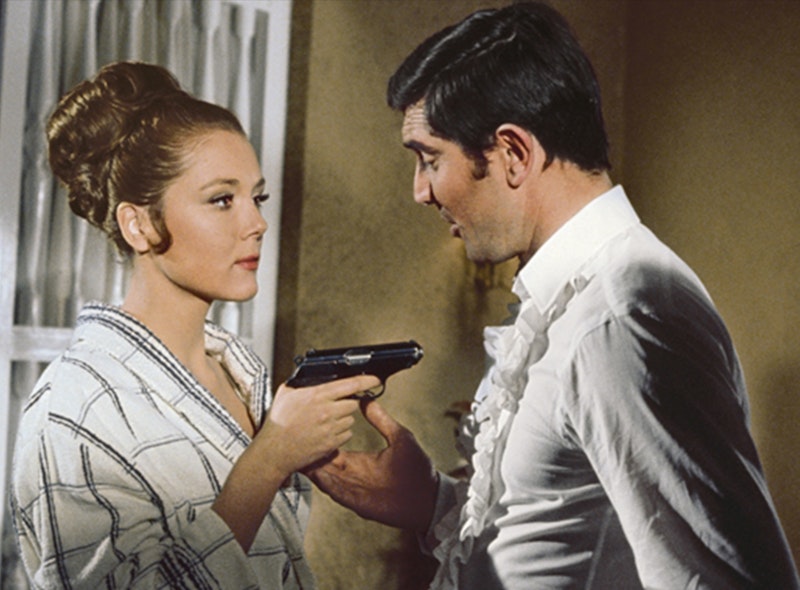In 2010, Christopher Nolan observed in an interview, “I think, [On] Her Majesty’s Secret Service would be my favorite Bond. It’s a hell of a movie, it holds up very well.” Steven Soderbergh wrote (in 2013, after Roger Deakins shot Skyfall) “For me there’s no question that cinematically On Her Majesty’s Secret Service is the best Bond film and the only one worth watching repeatedly for reasons other than pure entertainment.”
The movie wasn’t liked when it came out in 1969 and underperformed box-office expectations. But the general sentiment since agrees with Nolan and Soderbergh.
The plot’s not too far from Ian Fleming’s novel. James Bond (George Lazenby) has a dramatic encounter with a lovely woman named Countess Tracy di Vicenzo (Diana Rigg), who’s the daughter of mobster Marc-Ange Draco (Gabriele Ferzetti, dubbed by David de Keyser). Bond enlists Draco to help him find Ernst Stavro Blofeld (Telly Savalas), evil boss of the criminal organization SPECTRE, in exchange for Bond’s help in snapping Tracy out of her suicidal depression. When Blofeld’s found running a medical clinic in the Swiss Alps under a false identity, Bond infiltrates the clinic under a false identity of his own. Explosions happen, and a wedding, and a shocking twist ending.
The movie’s directed by Peter R. Hunt, longtime editor of the Bond films, and from the first fight scene on a beach at sunset the camera angles are more interesting, the compositions more engaging. The lighting’s darker and more textured. The film also has the goriest on-screen death to this point in the series, when a man falls into a snow-blower. The process photography shots are poor, almost a tradition in the Bond movies, but the set-pieces are well-conceived; an extended chase sequence on skis establishes a motif the series will return to many times.
Ken Adam is gone as production designer, but Syd Cain takes over without missing a beat. Cain collaborated with Adam on the previous films and uses that experience to create a slightly more grounded world. Blofeld’s mountain lair is less starkly modernist than the hidden bases Adams designed, but still has a distinctive late-1960s feel. Conversely, the evocation of both old-world wealth and the workaday world is convincing. When Bond visits the College of Arms you can smell the leather of the book bindings; when he breaks into a lawyers’ office in Bern you feel the drizzle of the gray day outside.
This is what spy stories do, balancing high technology with the elegance of the past. Especially the spy stories of the 1960s, at their specific moment between tradition and modernity. Their art and architecture at times reflect a complex inheritance from the past, making us aware of the knowledge possessed by a true expert in a given field, and then sometimes reflect the ultramodern potential of the future, both liberating and threatening. When Bond tries to recover stolen atomic bombs or, as here, stop a scheme involving subliminal brainwashing and bioterror, he’s trying to ensure that the technology of the future remains in authorized hands.
The movie’s playing-about with its era is unintentionally pointed up by a jabot Bond wears at one point when in disguise. It’s the piece of lace that Austin Powers wears at his neck; fashionable when the movie was made, in the Austin Powers films it’s a visual signifier of the Swinging 1960s. The Bond films have had a curious aversion to referring to youth culture, perhaps because the novels were mostly written in the 1950s, but as films became more open to sexuality, Bond swipes a guy’s Playboy and spends time bouncing between women in a harem-like situation in Blofeld’s clinic.
Which may also reflect the new Bond in this movie: Sean Connery’s out, and former model George Lazenby is in. The Australian Lazenby has a hapless and easygoing air, not traditionally Bondian but effective. For someone not trained as an actor, he handles himself well, helped by the fact that he’s dubbed by George Baker for the scenes in which he goes undercover.
Still, it’s regrettable that this is one of the few early Bond films where Bond’s given an actual character arc. Lazenby’s watchable, but you wonder how a trained actor like Connery would’ve handled the material. (Then again, I note a line where one of the young ladies in Blofeld’s clinic teases Bond for pretending he didn’t like girls; if Lazenby had been trying to act camp in earlier scenes, it’s not obvious today, and one is thankful for small mercies.)
Telly Savalas isn’t ineffective as the villain, but even if you don’t have memories of Kojak he’s an odd choice to play a man aspiring to aristocracy. Much better is Diana Rigg, as Bond’s love interest and eventual wife. It’s unfortunate she’s given the job of being captured so Bond can ride to the rescue, unusual for the Bond films to this point, but she effectively portrays a privileged woman at once driven, depressed, and resourceful.
And this is good because the movie plays up the romance between Tracy di Vicenzo and Bond to an unusual degree. Structurally, it starts as a romance film, concerned with the relationship, and it takes some time before the SPECTRE plot really gets rolling. At times the SPECTRE storyline even feels like a sidetrack from the romance the movie really wants to be about.
The downbeat ending does bring both strands together effectively, but the movie has a smaller scale than the previous films. Blofeld’s scheme isn’t visually interesting, and his base isn’t as eye-catching or dramatic as previous villain bases. Still, not only is On Her Majesty’s Secret Service overall a striking piece of cinema, it’s an effective bit of pop filmmaking. Most relevant for the Bond films, it showed that recasting the central role could work, which would be useful knowledge in the future.

